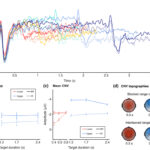It has been observed that humans can implicitly learn and ignore a salient distractor when it frequently appears in a specific location. However, neural mechanisms behind distractor suppression in the brain are still unclear. Recently, a study conducted by Bei Zhang and colleagues (Zhang et al., 2022) used a probability-cueing visual search paradigm along with fMRI scanning. The study showed that the reduction of distractor interference from the same target-dimension was linked to the distractor-evoked visual activity in the early visual cortex. This suggests that the statistical learning of frequent distractor location is suppressed in the early visual cortex when the distractor and target lie in the same dimension.
Reference
Zhang, B., Weidner, R., Allenmark, F., Bertleff, S., Fink, G. R., Shi, Z., & Müller, H. J. (2022). Statistical learning of frequent distractor locations in visual search involves regional signal suppression in early visual cortex. Cerebral Cortex , 32(13), 2729–2744. https://doi.org/10.1093/cercor/bhab377




